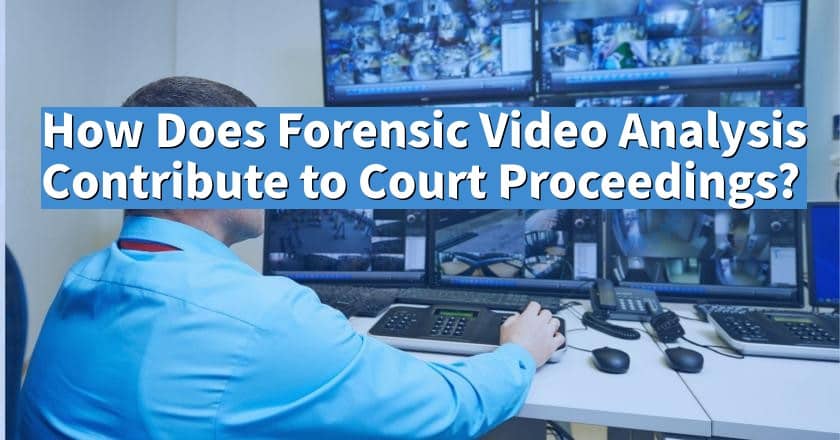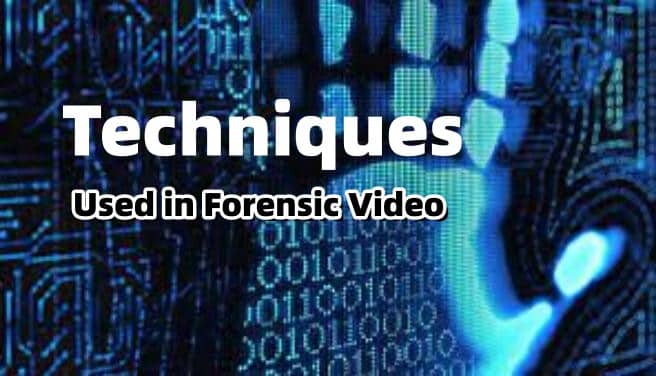How Forensic Video Analysis Contribute to Court Proceedings?

-
Content
- Intro
- Establishing Facts and Evidence
- Enhancing Juror Understanding
- Ensuring Fairness and Justice
- Techniques Used in Forensic Video
- Transformative Cases and Technological Breakthroughs
- Conclusion
-
Content
- Intro
- Establishing Facts and Evidence
- Enhancing Juror Understanding
- Ensuring Fairness and Justice
- Techniques Used in Forensic Video
- Transformative Cases and Technological Breakthroughs
- Conclusion
Intro
Forensic video analysis is like using a magnifying glass to look at videos that are part of court cases. It helps figure out what really happened during an event by examining videos very closely in the field of video forensics. This is super important because videos can be strong evidence in court. They can show things exactly as they happened, which can help judges and juries make fair decisions. When experts analyse videos, they use video forensic tools to notice small details that might be hard to see at first. This could be anything from how a person was moving to the time something happened. These details can help prove what happened and who was involved. Videos are helpful in court because they can provide clear facts. They can support what witnesses say or show a different side of the story. With forensic video analysis, everyone in court can have a better understanding of the case. It makes the evidence stronger and helps make sure that the final decision is based on solid facts. This way, the court can be as fair as possible to everyone involved.
Establishing Facts and Evidence
When it comes to proving facts in court, forensic video analysis plays a crucial role. First, it helps present clear and compelling evidence. A video can show exactly what happened in a situation, making it easier for everyone in the courtroom to understand. It’s like having a silent witness that shows the truth without bias. This type of analysis can support what witnesses say. If someone in court tells their side of the story, a video analyzed by experts can confirm if their account matches up with what happened. This can make the witness’s testimony stronger and more believable. The videos give a visual picture of events. Sometimes, words alone can’t fully describe a situation, but a video can capture every detail vividly. This visual representation can be especially powerful in court, where seeing something can have a much bigger impact than just hearing about it. Forensic video analysis is key to making evidence stronger in legal cases. It helps ensure that the facts are clear, supports what witnesses say, and gives everyone in court a clear picture of what really happened. This helps judges and juries make fair and informed decisions.
Enhancing Juror Understanding
Forensic video analysis is super helpful for jurors in a courtroom, especially when they’re trying to understand complex cases. Imagine trying to figure out a complicated puzzle; that’s what it’s like for jurors sometimes. But, when they have videos to look at, it’s like someone gave them a guide to solve that puzzle. Videos act as visual aids, making it easier for jurors to see and understand what happened. Also, videos are great for showing the order of events, just like a timeline. They can show what happened first, what came next, and so on. This is important in court because knowing the exact sequence of events can help jurors decide what’s true and what’s not. By watching analysed videos, jurors get a clearer picture of the situation. They don’t have to rely only on what people say happened; they can see it for themselves. This makes it easier for them to make decisions because they have a better understanding of the case. Forensic video analysis makes things less confusing and helps ensure that justice is served based on digital evidence.
Ensuring Fairness and Justice
In the pursuit of fairness and justice within the courtroom, forensic video analysis stands out as a beacon of impartiality. The objective analysis of video evidence ensures that conclusions are drawn based on facts rather than assumptions. Experts in this field use scientific methods to examine videos, making sure that their findings are accurate and unbiased. This level of precision is crucial in maintaining the integrity of the legal process, ensuring that every piece of evidence presented is thoroughly vetted for its truthfulness.
One of the most significant benefits of forensic video analysis is its potential to prevent wrongful convictions. By providing clear, objective evidence, it helps ensure that innocent individuals are not unjustly punished due to misinterpretation of evidence or reliance on faulty testimonies. This critical analysis can highlight discrepancies in witness statements or reveal new information that could exonerate the accused, thus playing a pivotal role in delivering justice. For video evidence to be considered in court, it must meet specific standards for admissibility. Forensic video analysis ensures that the evidence complies with legal requirements, such as authenticity and relevance to the case. By establishing a chain of custody and verifying the integrity of the video, forensic analysts help maintain the evidence’s credibility, ensuring it can be legitimately used in proceedings.
Expert testimony and opinions derived from forensic video analysis carry substantial weight in court. Forensic video analysts not only present the findings but also explain the methodologies used to arrive at their conclusions, lending credibility and clarity to the evidence. Their insights can demystify complex technical details, making it easier for judges and jurors to understand the significance of the video evidence in the context of the case. Forensic video analysis plays a critical role in upholding the principles of fairness and justice in the legal system. By ensuring that video evidence is accurate, reliable, and meets legal standards, forensic video analysis contributes to informed decision-making in court, thereby safeguarding the integrity of judicial outcomes.
Techniques Used in Forensic Video
In the meticulous field of forensic video analysis, a variety of sophisticated techniques are employed to extract and refine evidence from video footage, each contributing to the integrity and utility of video evidence in legal settings.
1. Video Enhancement and Clarification
This fundamental technique involves adjusting aspects of video footage such as brightness, contrast, and sharpness to make details clearer. Often, crucial evidence may be hidden within poorly lit or blurry video segments. Video enhancement tools allow forensic analysts to uncover these obscured details, such as facial features or license plate numbers, making them discernible for evaluation. This process can be pivotal in identifying persons of interest or understanding the sequence of events.
2. Authentication and Validation of Video Evidence
Ensuring that video evidence has not been tampered with is paramount. Authentication involves verifying the originality of the footage, confirming that it presents an unaltered and accurate depiction of the event. Validation procedures might include checking the file’s metadata for timestamps and origin or analyzing the video for signs of manipulation. This step establishes the credibility of the video as a legitimate piece of evidence.
3. Facial Recognition and Object Tracking
These advanced techniques involve identifying and following the movement of specific individuals or objects across multiple video frames or even different video sources. Facial recognition technology can pinpoint a person in a crowd, while object tracking can keep tabs on a vehicle or item of interest throughout the video. These capabilities are crucial in establishing timelines and linking suspects to specific locations or actions.
4. Metadata Analysis and Geo-location
Metadata embedded in video files can provide a wealth of information, including the date, time, and location of the recording. Analyzing this data can help corroborate the timeline of events or the presence of individuals at a particular scene. Geo-location uses geographical data from the video to pinpoint where it was recorded, which can be instrumental in reconstructing events or establishing alibis.
Transformative Cases and Technological Breakthroughs
Case 1: The Boston Marathon Bombing (2013)
In the aftermath of the tragic Boston Marathon bombing, forensic video analysis played a crucial role in identifying the suspects. Investigators sifted through countless hours of surveillance footage from businesses and public cameras near the event. By enhancing and analyzing these videos, forensic experts were able to pinpoint the suspects amidst the chaotic crowd, leading to their eventual identification and capture. This case highlighted the power of video analysis in piecing together evidence from seemingly mundane footage, proving instrumental in solving a high-profile case.
Case 2: The London Riots (2011)
During the 2011 London riots, the city faced widespread disorder and criminal activity. Forensic video analysts were tasked with examining extensive CCTV footage to identify perpetrators. Techniques such as facial recognition and object tracking enabled authorities to track down and prosecute individuals involved in the riots, showcasing the effectiveness of video analysis in restoring order and holding rioters accountable for their actions.
Case 3: SalvationDATA’s VIP 2.0 in Action
SalvationDATA‘s VIP (Video Investigation Portable) 2.0 represents a significant advancement in forensic video analysis technology. In one notable case, VIP 2.0 was utilized to recover critical video evidence that had been intentionally deleted by a suspect. The tool’s advanced video recovery capabilities, including the ability to bypass DVR passwords and recover lost, deleted, or fragmented files, proved invaluable. Furthermore, VIP 2.0’s intelligent video retrieval and analysis features, such as human and vehicle identification and motion detection, allowed forensic investigators to efficiently sift through vast amounts of footage to pinpoint relevant evidence. This case exemplifies how cutting edge tools like VIP 2.0 are transforming the field of forensic video analysis, making it possible to extract and analyze video data more effectively, even in the face of deliberate attempts to obstruct justice.
Conclusion
In conclusion, forensic video analysis has proven to be an indispensable tool in the quest for justice, offering clarity and objectivity in court proceedings. Through the enhancement and clarification of video evidence, authentication of footage, and the application of advanced techniques like facial recognition and geolocation, forensic video analysis brings critical insights to light. It not only aids in presenting compelling evidence but also enhances juror understanding by providing a clear visual representation of events. Furthermore, it upholds the principles of fairness and justice by ensuring the objective analysis of video evidence, thus preventing wrongful convictions, and ensuring that evidence meets the rigorous standards of admissibility. The case studies, including the impactful use of SalvationDATA’s VIP 2.0, illustrate the profound effect that sophisticated forensic video tools have on uncovering the truth in complex cases. As technology evolves, the field of forensic video analysis will continue to play a pivotal role in legal systems worldwide, ensuring that justice is served with the support of undeniable video evidence.



